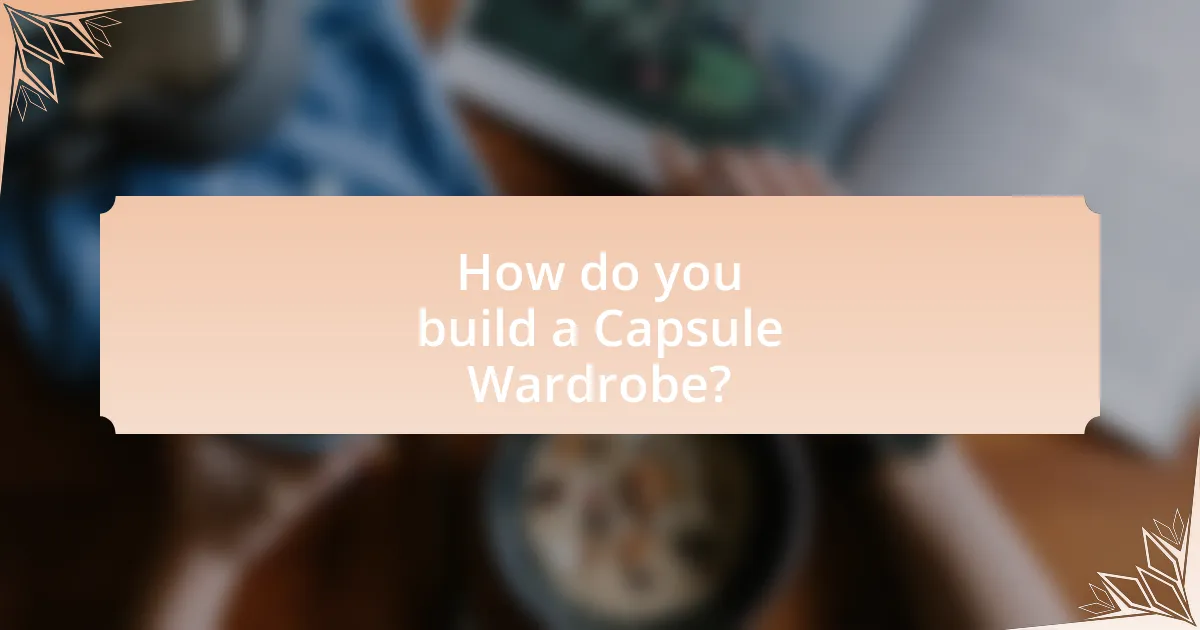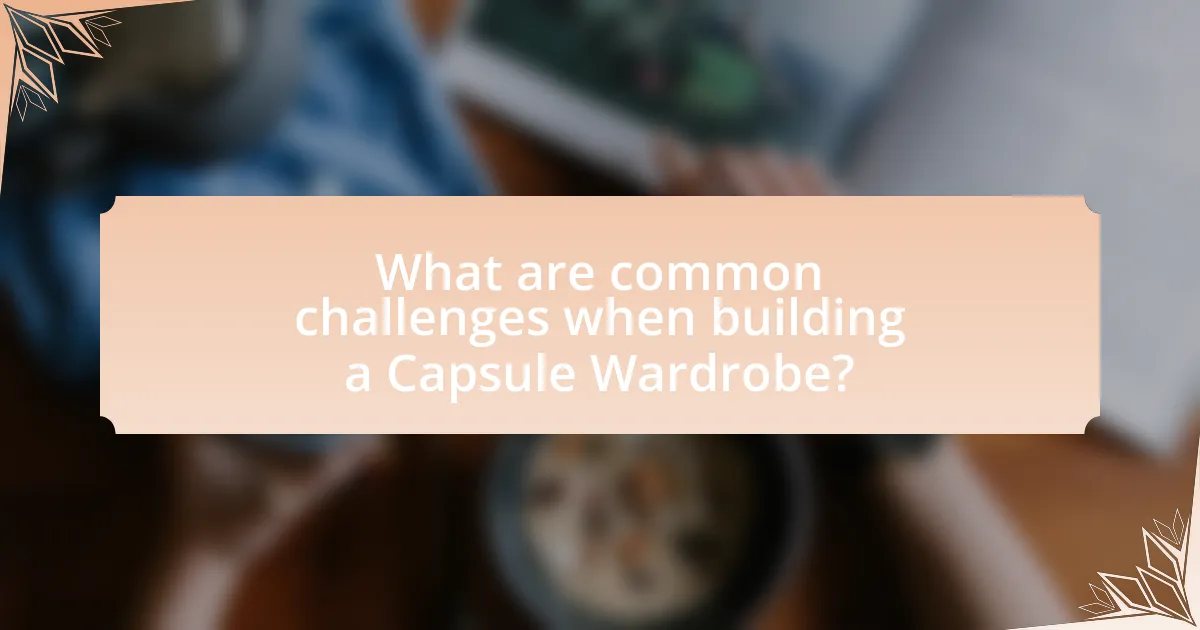A capsule wardrobe is a curated collection of essential clothing items designed for versatility and minimalism, typically comprising 20 to 40 high-quality pieces that can be mixed and matched. This article explores the concept of capsule wardrobes, highlighting their differences from traditional wardrobes, key characteristics, and the benefits they offer, such as reduced decision fatigue and enhanced sustainability. It provides practical steps for building and maintaining a capsule wardrobe, including selecting versatile pieces, determining personal style, and adapting the collection for different occasions. Additionally, it addresses common challenges and offers resources for further guidance on creating a timeless and functional wardrobe.

What is a Capsule Wardrobe?
A capsule wardrobe is a curated collection of essential clothing items that can be mixed and matched to create various outfits. This concept emphasizes quality over quantity, typically consisting of a limited number of versatile pieces that reflect an individual’s personal style. The idea originated in the 1970s, popularized by designer Susie Faux, who advocated for a minimalist approach to fashion, allowing individuals to simplify their wardrobe while maximizing outfit options.
How does a Capsule Wardrobe differ from a traditional wardrobe?
A capsule wardrobe differs from a traditional wardrobe primarily in its size and focus on versatility. A capsule wardrobe typically consists of a limited number of essential, high-quality pieces that can be mixed and matched, usually around 30 to 40 items, while a traditional wardrobe may contain a larger variety of clothing, often exceeding 100 items. This streamlined approach in a capsule wardrobe promotes intentionality in clothing choices, reduces decision fatigue, and encourages sustainable fashion practices by minimizing excess.
What are the key characteristics of a Capsule Wardrobe?
A Capsule Wardrobe is characterized by a limited selection of versatile clothing items that can be mixed and matched to create various outfits. This wardrobe typically includes high-quality, timeless pieces that reflect the individual’s personal style and can be worn across multiple seasons. The concept emphasizes minimalism, encouraging fewer but more meaningful clothing choices, which reduces decision fatigue and promotes sustainability. Research indicates that a well-curated Capsule Wardrobe can lead to increased satisfaction with one’s clothing choices and a more organized lifestyle.
Why is minimalism important in a Capsule Wardrobe?
Minimalism is important in a Capsule Wardrobe because it promotes simplicity and efficiency in clothing choices, allowing individuals to create a versatile and cohesive collection. By focusing on a limited number of high-quality pieces, minimalism reduces decision fatigue and enhances personal style, making it easier to mix and match outfits. Studies show that a streamlined wardrobe can lead to increased satisfaction and reduced stress related to clothing selection, as individuals spend less time managing excess items.
What are the benefits of having a Capsule Wardrobe?
A capsule wardrobe offers several benefits, including simplicity, cost-effectiveness, and reduced decision fatigue. By curating a limited selection of versatile clothing items, individuals can streamline their daily outfit choices, saving time and mental energy. Research indicates that a simplified wardrobe can lead to increased satisfaction and reduced stress related to clothing decisions. Additionally, investing in quality pieces rather than numerous fast-fashion items can lead to long-term savings, as these items tend to last longer and require less frequent replacement.
How does a Capsule Wardrobe save time and reduce stress?
A capsule wardrobe saves time and reduces stress by simplifying clothing choices and minimizing decision fatigue. With a limited selection of versatile, high-quality pieces, individuals can quickly assemble outfits without the overwhelming options typically found in larger wardrobes. Research indicates that reducing choices can lead to improved mental clarity and decreased anxiety, as seen in studies on decision-making and cognitive load. By streamlining the wardrobe, individuals spend less time getting dressed and more time focusing on other important activities, ultimately enhancing overall well-being.
In what ways can a Capsule Wardrobe contribute to sustainability?
A Capsule Wardrobe contributes to sustainability by promoting minimalism and reducing clothing consumption. By focusing on a limited selection of versatile, high-quality pieces, individuals can decrease the frequency of purchases, which in turn lowers the demand for fast fashion production. Fast fashion is responsible for significant environmental degradation, with the industry contributing to 10% of global carbon emissions and generating massive textile waste. Additionally, a Capsule Wardrobe encourages the use of durable materials, which can extend the lifespan of clothing, further mitigating waste and resource depletion. This approach not only supports sustainable fashion practices but also fosters a more conscious consumer mindset.

How do you build a Capsule Wardrobe?
To build a capsule wardrobe, start by selecting a limited number of versatile clothing pieces that can be mixed and matched. Typically, a capsule wardrobe consists of 20 to 40 items, including tops, bottoms, outerwear, and shoes, focusing on neutral colors and classic styles that suit your lifestyle. This approach simplifies daily outfit choices and promotes sustainability by reducing overconsumption. Research indicates that a well-curated capsule wardrobe can enhance personal style and reduce decision fatigue, making it easier to dress efficiently.
What steps are involved in creating a Capsule Wardrobe?
Creating a Capsule Wardrobe involves several key steps: first, assess your current wardrobe to identify items you love and wear frequently. Next, define your personal style by considering your lifestyle, preferences, and the occasions you dress for. After that, select a limited number of versatile pieces that can be mixed and matched, typically around 30 to 40 items, including tops, bottoms, outerwear, and shoes. Then, focus on quality over quantity by choosing durable fabrics and well-fitting garments. Finally, regularly evaluate and update your capsule wardrobe to ensure it remains aligned with your evolving style and needs. These steps are essential for building a functional and timeless collection.
How do you determine your personal style for a Capsule Wardrobe?
To determine your personal style for a Capsule Wardrobe, start by assessing your lifestyle, preferences, and body type. This involves identifying the types of clothing that make you feel comfortable and confident, as well as considering the activities you engage in regularly. For example, if you work in a corporate environment, your style may lean towards professional attire, while a more casual lifestyle might favor relaxed, versatile pieces.
Next, analyze your existing wardrobe to pinpoint which items you wear most often and why. This can reveal patterns in color, fit, and style that resonate with you. Research indicates that individuals who curate their wardrobes based on personal style tend to experience higher satisfaction and reduced decision fatigue (source: “The Psychology of Clothing,” Journal of Fashion Marketing and Management, authors: Kim, H. & Kim, S.).
Finally, create a mood board or a list of style icons that inspire you, which can help clarify your aesthetic preferences. By combining these elements, you can effectively define your personal style, ensuring that your Capsule Wardrobe reflects who you are while remaining functional and cohesive.
What criteria should you use to select clothing items?
To select clothing items for a capsule wardrobe, prioritize versatility, quality, fit, and personal style. Versatility ensures that each piece can be mixed and matched with others, maximizing outfit options. Quality is essential as it affects the longevity and durability of the clothing; investing in well-made items reduces the need for frequent replacements. Fit is crucial because well-fitting clothes enhance appearance and comfort, leading to more frequent wear. Lastly, personal style should guide selections to ensure that the wardrobe reflects individual preferences and lifestyle needs. These criteria collectively contribute to a functional and timeless collection.
How can you effectively curate your Capsule Wardrobe?
To effectively curate your Capsule Wardrobe, start by selecting versatile, high-quality pieces that can be mixed and matched. Focus on a limited color palette to ensure cohesion among items, which allows for more outfit combinations. Research indicates that a well-curated Capsule Wardrobe typically consists of 30 to 40 essential items, including tops, bottoms, outerwear, and shoes, which can cover various occasions. This approach not only simplifies daily outfit choices but also promotes sustainability by reducing overconsumption.
What types of clothing should be included in a Capsule Wardrobe?
A capsule wardrobe should include essential clothing items that are versatile and timeless. Key types of clothing to include are basic tops, such as t-shirts and blouses; bottoms like jeans and tailored trousers; outerwear, including a classic blazer and a versatile coat; and dresses that can be dressed up or down. Additionally, incorporating a few pairs of shoes, such as ankle boots and classic flats, along with accessories like a quality handbag and a scarf, enhances the functionality of the wardrobe. This selection allows for numerous outfit combinations, maximizing utility while minimizing clutter.
How do you choose versatile pieces for maximum outfit combinations?
To choose versatile pieces for maximum outfit combinations, select items that can be easily mixed and matched across various styles and occasions. Focus on neutral colors, classic cuts, and high-quality fabrics that withstand trends, allowing for seamless integration into different outfits. For example, a tailored blazer can elevate casual wear or complement formal attire, while a pair of well-fitted jeans can transition from day to night. Research indicates that a capsule wardrobe consisting of 30-40 essential pieces can provide over 100 outfit combinations, demonstrating the effectiveness of strategic selection in maximizing versatility.

What are common challenges when building a Capsule Wardrobe?
Common challenges when building a Capsule Wardrobe include selecting versatile pieces, maintaining a cohesive color palette, and resisting the temptation to over-purchase. Selecting versatile pieces can be difficult because individuals often struggle to identify clothing that can be styled in multiple ways. Maintaining a cohesive color palette is challenging as it requires careful consideration of personal style and existing wardrobe items to ensure compatibility. Resisting the temptation to over-purchase is a significant hurdle, as many people find it hard to limit their choices, leading to a cluttered wardrobe that defeats the purpose of a capsule collection.
How can you overcome decision fatigue when selecting items?
To overcome decision fatigue when selecting items, streamline your choices by limiting the number of options available. Research indicates that having too many choices can lead to paralysis and dissatisfaction, as shown in a study by Iyengar and Lepper (2000), which found that participants offered fewer options were more likely to make a choice and feel satisfied with it. Additionally, establishing a clear set of criteria for selection can simplify the decision-making process, allowing you to focus on what truly matters in your capsule wardrobe. By curating a smaller, versatile collection, you reduce the cognitive load associated with decision-making, leading to more efficient and satisfying selections.
What strategies can help you stick to your Capsule Wardrobe plan?
To stick to your Capsule Wardrobe plan, establish clear guidelines for your wardrobe choices. Defining a specific number of items, such as 30 to 40 pieces, helps maintain focus and prevents over-accumulation. Regularly assess your wardrobe to ensure items align with your lifestyle and personal style, which reinforces commitment to the plan. Additionally, creating a seasonal rotation can keep your wardrobe fresh and engaging, making it easier to adhere to the Capsule Wardrobe concept. Research indicates that a simplified wardrobe can reduce decision fatigue, leading to more consistent adherence to the plan.
How do you handle seasonal changes with a Capsule Wardrobe?
To handle seasonal changes with a Capsule Wardrobe, one should rotate clothing items based on the season while maintaining a core collection. This involves assessing the current wardrobe, removing items that are not suitable for the upcoming season, and adding seasonal pieces that complement the existing items. For example, during winter, heavier fabrics and layers are introduced, while lighter fabrics and breathable materials are favored in summer. This method ensures versatility and functionality, allowing for a cohesive look throughout the year. Studies show that a well-curated Capsule Wardrobe can reduce decision fatigue and enhance personal style, making seasonal transitions smoother and more efficient.
What are some tips for maintaining a Capsule Wardrobe?
To maintain a Capsule Wardrobe, regularly assess and curate your clothing collection to ensure it aligns with your lifestyle and personal style. This involves periodically reviewing each item for wear and relevance, removing pieces that no longer fit or are not worn frequently. Additionally, focus on quality over quantity by investing in versatile, durable pieces that can be mixed and matched easily. Research indicates that a well-maintained Capsule Wardrobe can reduce decision fatigue and enhance personal style, as seen in studies on minimalist fashion choices.
How often should you reassess your Capsule Wardrobe?
You should reassess your Capsule Wardrobe at least twice a year. This frequency allows you to evaluate your clothing choices in relation to seasonal changes and personal style evolution. Research indicates that regular reassessment helps maintain a functional and cohesive wardrobe, ensuring that items remain relevant and aligned with your lifestyle needs.
What are the best practices for keeping your Capsule Wardrobe organized?
The best practices for keeping your Capsule Wardrobe organized include categorizing items by type, maintaining a consistent color palette, and regularly assessing your collection. Categorizing items, such as separating tops, bottoms, and outerwear, enhances visibility and accessibility, making it easier to mix and match outfits. A consistent color palette simplifies coordination, allowing for versatile combinations and reducing decision fatigue. Regularly assessing your collection, ideally every season, ensures that you remove items that no longer fit your style or needs, thereby maintaining a streamlined and functional wardrobe. These practices contribute to an efficient and aesthetically pleasing Capsule Wardrobe.
How can you adapt your Capsule Wardrobe for different occasions?
To adapt your Capsule Wardrobe for different occasions, select versatile pieces that can be styled in multiple ways. For example, a classic blazer can be paired with tailored trousers for a professional setting or with jeans for a casual outing. Incorporating accessories such as scarves, statement jewelry, or different shoes can also transform an outfit from day to night. Additionally, layering items like cardigans or vests can provide flexibility for varying temperatures and settings. This approach allows for a cohesive yet adaptable wardrobe that meets diverse needs without excessive clothing.
What accessories can enhance your Capsule Wardrobe for special events?
Accessories that can enhance a Capsule Wardrobe for special events include statement jewelry, elegant handbags, versatile shoes, and tailored outerwear. Statement jewelry, such as bold necklaces or chandelier earrings, can elevate a simple outfit, making it suitable for formal occasions. Elegant handbags, particularly in classic colors like black or metallic, add sophistication and functionality. Versatile shoes, such as classic pumps or stylish ankle boots, can complement various outfits while providing comfort. Tailored outerwear, like a chic blazer or a tailored coat, can add polish and warmth, making any ensemble appropriate for special events. These accessories not only enhance the overall look but also allow for personalization within a streamlined wardrobe.
How do you transition your Capsule Wardrobe from day to night?
To transition your Capsule Wardrobe from day to night, start by swapping daytime pieces for evening-appropriate alternatives. For instance, replace a casual top with a dressy blouse and switch from flats to heels. Accessories play a crucial role; adding statement jewelry or a clutch can elevate the look significantly. According to fashion experts, these simple changes can transform an outfit while maintaining the core elements of your Capsule Wardrobe, ensuring versatility and style.
What are the best resources for building a Capsule Wardrobe?
The best resources for building a Capsule Wardrobe include books, websites, and apps that provide guidance on selecting versatile clothing pieces. Notable books such as “The Capsule Wardrobe: 1,000 Outfits from 30 Pieces” by Wendy Mak and “The Curated Closet” by Anuschka Rees offer structured approaches and practical tips. Websites like Unfancy and Project 333 provide inspiration and community support, while apps like Cladwell help users track outfits and plan their wardrobes effectively. These resources are widely recognized for their effectiveness in helping individuals create a functional and stylish capsule wardrobe.
Which books or websites provide valuable insights on Capsule Wardrobes?
Books that provide valuable insights on capsule wardrobes include “The Capsule Wardrobe: 1,000 Outfits from 30 Pieces” by Wendy Mak and “The Curated Closet” by Anuschka Rees. Websites such as Unfancy and The Minimalists also offer practical advice and inspiration for creating capsule wardrobes. These resources emphasize the principles of minimalism and intentionality in fashion, helping individuals streamline their clothing choices effectively.
How can social media influence your Capsule Wardrobe choices?
Social media can significantly influence your Capsule Wardrobe choices by exposing you to current fashion trends, style inspirations, and community feedback. Platforms like Instagram and Pinterest showcase curated outfits and minimalist styles, which can inspire individuals to select versatile pieces that align with their personal aesthetic. Research indicates that 72% of consumers are influenced by social media when making fashion purchases, highlighting its role in shaping wardrobe decisions. Additionally, social media allows for engagement with fashion influencers and communities, providing insights into how to mix and match items effectively, thereby enhancing the overall functionality of a Capsule Wardrobe.
What practical tips can help you successfully build a Capsule Wardrobe?
To successfully build a Capsule Wardrobe, start by defining a color palette that reflects your personal style and can be easily mixed and matched. This approach ensures versatility and cohesion in your outfits. Next, select a limited number of high-quality, timeless pieces that fit well and suit various occasions, such as classic jeans, a tailored blazer, and versatile tops. Research indicates that a Capsule Wardrobe typically consists of 30 to 40 items, which allows for a functional yet minimalistic approach to dressing. Additionally, regularly assess your wardrobe to remove items that no longer serve you, ensuring that your collection remains relevant and aligned with your lifestyle.